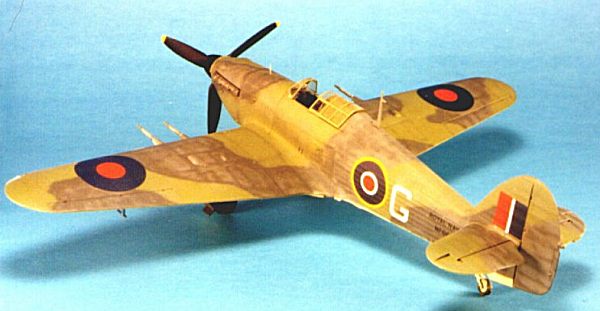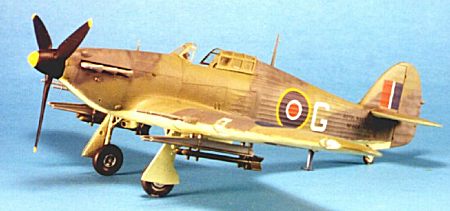
|
KIT: |
Hasegawa 1/48 Sea Hurricane IIc |
|
KIT # |
09274 |
|
PRICE: |
$29.98 |
|
DECALS: |
See Review |
|
REVIEW & |
|
|
NOTES: |
Aftermarket decals: Aeromaster 48-195/440 |
Editors Note: this is the third of three installments from Tom Cleaver on the building of three Hasegawa 1/48 Hurricanes.
Sea Hurricane IIc, 825 Squadron, HMS "Vindex," March 1944:

825 Squadron provided anti-submarine protection for Atlantic convoys during the winter and spring of 1944, flying off the escort carrier HMS "Vindex." The Squadron CO, Lt. Cdr. Percy Glick, had five of the squadron aircraft adapted to use the 60-lb RPs that were carried by the Swordfish that accompanied the Sea Hurricanes, with two rockets carried under each wing to supplement the four 20mm cannon.
Construction Notes:
 Hasegawa's
limited-run Sea Hurricane kit is basically the original Hurricane IIc kit
released in 1997, with a resin part that provides the A-frame arrestor hook;
this replaces the lower rear part of the fuselage. This is an easy conversion,
which requires the modeler to simply cut away the lower fuselage with a razor
saw from just ahead of the tail wheel, along a panel line that divides the lower
section from the fuselage side. Once the fuselage is assembled, the resin
replacement part is glued in place and the conversion is complete. Past that,
there are no other difficulties in constructing the model.
Hasegawa's
limited-run Sea Hurricane kit is basically the original Hurricane IIc kit
released in 1997, with a resin part that provides the A-frame arrestor hook;
this replaces the lower rear part of the fuselage. This is an easy conversion,
which requires the modeler to simply cut away the lower fuselage with a razor
saw from just ahead of the tail wheel, along a panel line that divides the lower
section from the fuselage side. Once the fuselage is assembled, the resin
replacement part is glued in place and the conversion is complete. Past that,
there are no other difficulties in constructing the model.
I decided to do this conversion after I got my Tamiya Swordfish; the kit comes with the rockets, which are not used for the Mk.I version. It was simple to line up the rocket rails and drill out holes in the lower wing for their attachment.
Painting and Finishing:
 I painted the
airplane in the standard FAA scheme of Extra Dark Sea Grey/Slate Grey/Sky, using
Tamiya XF-24 "Dark Grey" for the Extra Dark Sea Grey, and Tamiya XF-22
"RLM Grey" for Slate Grey, with XF-21 "Sky" for the lower
surfaces. I created the camouflage pattern as described above. Once I had
finished it, I lightened both the XF-22 and XF-24 with some XF-1 "Flat
White," and freehanded faded areas on different panels and panel lines, to
emphasize the wear and tear these airplanes underwent at sea.
I painted the
airplane in the standard FAA scheme of Extra Dark Sea Grey/Slate Grey/Sky, using
Tamiya XF-24 "Dark Grey" for the Extra Dark Sea Grey, and Tamiya XF-22
"RLM Grey" for Slate Grey, with XF-21 "Sky" for the lower
surfaces. I created the camouflage pattern as described above. Once I had
finished it, I lightened both the XF-22 and XF-24 with some XF-1 "Flat
White," and freehanded faded areas on different panels and panel lines, to
emphasize the wear and tear these airplanes underwent at sea.
Once the model was Futured, I used the markings provided on the Aeromaster "Sea Hurricanes At War, Part II" sheet, with no difficulties. After the decals were dry, I shadow-shaded with the Tamiya "smoke" mixture, and created exhaust stains on the fuselage.
I applied several coats of the "Flat Future" mixture to make the surface as dead flat as possible, which is the way the paint would end up when exposed to the saltwater environment aboard the carrier; since the Hurricane did not have folding wings, they remained on the flight deck throughout the voyage, exposed to the elements.
Conclusions:
 With the Hasegawa
line of Hurricanes, and the Aeromaster sheets of decals for so many different
Hurricanes, and the research knowledge available in Richard Franks' book and the
Squadron "Hurricane In Action" book, a modeler can create many
different and striking-looking models of this famous and important fighter.
With the Hasegawa
line of Hurricanes, and the Aeromaster sheets of decals for so many different
Hurricanes, and the research knowledge available in Richard Franks' book and the
Squadron "Hurricane In Action" book, a modeler can create many
different and striking-looking models of this famous and important fighter.
Research:
"Hurricane In Action," Squadron-Signal Publications
Franks, Richard: "The Hawker Hurricane: A Comprehensive Guide for the Modeller," SAM Publications